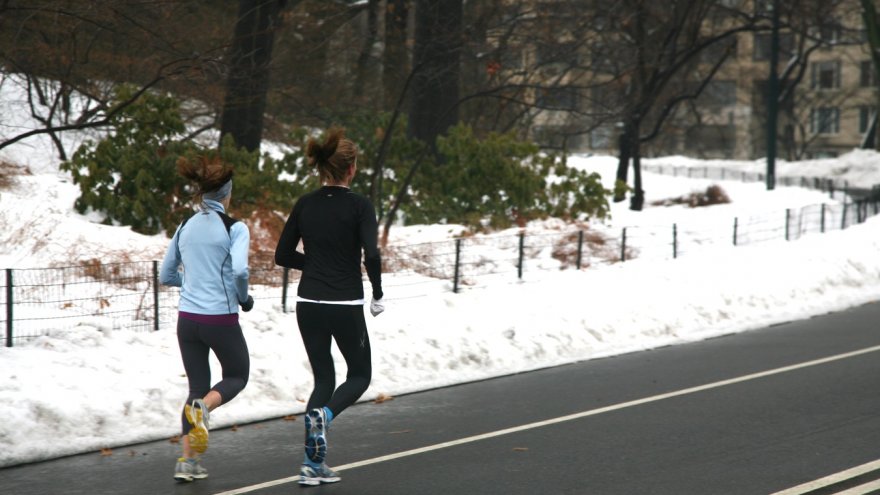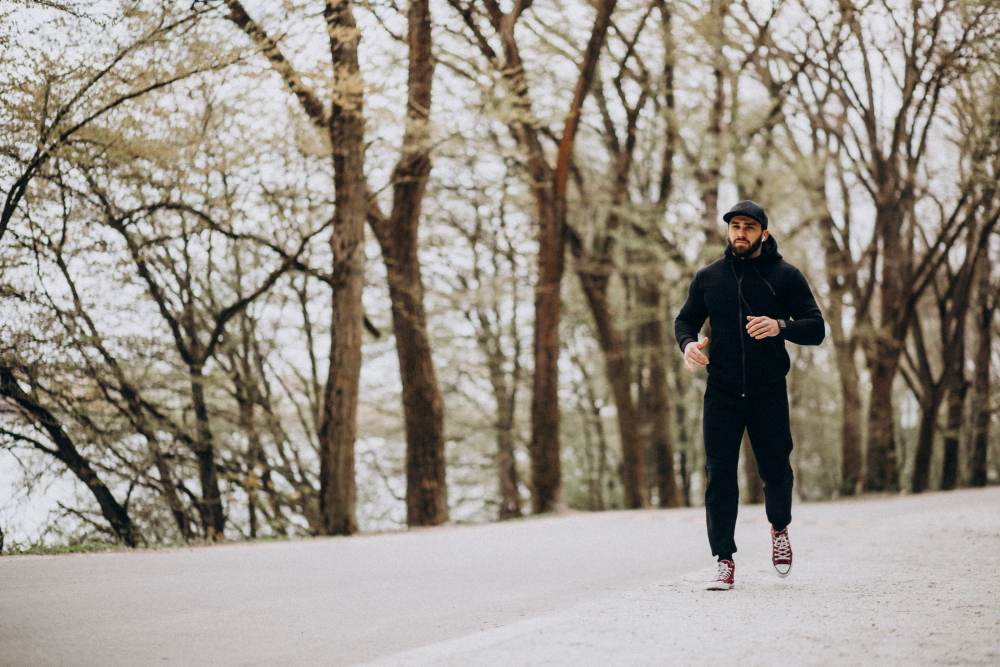Is It Harder to Run in Cold Weather?

Running in cold weather presents its own set of challenges, and some people may find it more difficult than running in milder conditions. These challenges include breathing cold air, muscle stiffness, and a challenging terrain.
Anyone who lives in a place with harsh winters will tell you that winter running is not for the weak-hearted. Believe it or not, you can get used to running in cold temperatures.
Does Cold Weather Affect Your Running?
Low temperatures can impact your running performance, but it is important to note that you won’t be disappointed in your results come spring. Struggling through the winter months can make for beautiful racing results when it warms up some.
You should anticipate slower training times and even difficulty breathing on super cold days. Just be patient with yourself and enjoy the journey.
Is it Normal to Have Trouble Breathing in Cold Weather?
Cold weather and dry air can irritate your bronchial tubes and lungs. This is why many people run with a neck gaiter pulled over their mouth.
As your body warms up, you may even be able to pull the mouth cover down, except on the very coldest days.
Is it Harder to Run in the Heat or Cold?
Whether running in the heat or cold is more challenging can vary from person to person and depends on individual preferences and physiological responses.
All runners and running coaches have their preferences. I would much rather run in a cold winter than a hot summer day.
When my body temperature gets too warm on a hot summer day, I cannot perform well. Many people respectfully disagree with me and love running in the heat and humidity.
How Cold is Too Cold for Running?
There isn’t a specific temperature that universally defines “too cold” for running.
If it is below zero with any wind chill at all, frostbite can occur on exposed skin as quickly as 30 minutes. This does not mean you can’t run outside if it is below zero, it is just important that you take precautions.
You will want to cover as much of your skin as possible when there is bitter cold air. Next, do shorter outdoor workouts these days and limit your time outside in the elements to less than 30 minutes.
My personal threshold temperature for running outside is -25 degrees Fahrenheit. I know people who run in much colder temps. What it boils down to is having the right gear.
Benefits of Running Outside in the Colder Temperatures
- Improved Calorie Burn:
- Your body works harder to maintain a stable internal temperature in the cold, which can potentially increase calorie burn compared to running in warmer conditions.
- Enhanced Endurance:
- Cold weather can help improve endurance by reducing the risk of overheating, allowing you to sustain your pace for longer durations.
- Mood Boost:
- Outdoor exercise, even in the cold, has been linked to improved mood and reduced feelings of stress and anxiety. Exposure to natural light can also enhance mood.
- Fresh Air and Oxygen Intake:
- Cold, crisp air can feel invigorating and provide an increased intake of fresh oxygen, contributing to a sense of alertness and well-being.
- Improved Focus and Mental Clarity:
- The cold air can be mentally stimulating, helping to sharpen focus and mental clarity during your run.
- Vitamin D Production:
- Exposure to natural sunlight, even in colder temperatures, can contribute to the production of vitamin D. This is important for overall health, including bone health and immune function.
- Variety in Training:
- Running in different weather conditions adds variety to your training routine, helping to prevent monotony and keeping your workouts interesting.
- Adaptation to Temperature Extremes:
- Training in a range of temperatures helps your body adapt to different conditions, making you a more versatile and resilient runner.
- Community Engagement:
- Some running communities thrive in the winter, organizing fun runs, races, or themed events that can add a social element to your winter running routine.
- Sense of Accomplishment:
- Conquering the challenges of running in the cold, such as dealing with wind or icy conditions, can provide a sense of accomplishment and boost your mental toughness.

Running in Cold Weather: Tips for a More Comfortable Run
- Acclimate: Someone who lives in a warm climate will feel the harsh effects of cold weather running as it hits them like a freight train. One big tip is to run outside as it slowly gets colder. This gives you time to acclimate to it getting increasingly colder.
- Clothing: The right running gear is especially crucial as it gets cold outside. We have some tips, especially for that, including the layering for winter weather conditions.
- Safety Gear: With the colder weather comes shorter days. Having adequate safety gear to ensure you are visible to oncoming traffic is essential. Purchase some reflective gear, and be sure you have a headlamp to see where you are going.
- Shoes: Some people choose water-resistant shoes for winter running. If you run on slippery roads, there are products like Yak Tracks to help you stay upright on snow and ice.
- Slow Down: We are not trying to say you can’t run fast or work hard in the winter months. Just recognize that you will need to slow down as the temperature drops.
- Warm Up and Cool Down: Many runners neglect the essential warm-up routine. While warming up your body adequately is always important, it is even more so during the winter months.
Must-Have Cold Weather Running Gear
- Base Layers: The layers closest to your body, also called base layers, are often made of a wicking material. Many runners refer to this as dry-fit. I start with a tank top, add a long-sleeved shirt, then put my top layers over that.
- Cover Your Core: Keeping your body’s core warm is very important. One straightforward running tip is to purchase some running vests to keep the center of your body toasty.
- Face Cover: In very bitter cold temperatures, many runners use a face cover to protect their face from cold exposure. Gaiters, balaclavas, or buffs pull up and cover your neck, chin, and mouth. They can range from very thin to thick and warm.
- Hands: Choosing between gloves, mittens, or glittens is a personal preference. Mittens can help warm your hands in freezing temperatures as your fingers keep each other warm.
- Head Cover: Decide exactly what type of head covering you need based on the air temperature and wind chill. They make headbands that are quite thin, as well as those that are very thick and warm. Hats also come in various thicknesses and offer various levels of protection against the elements. Covering your head is a great way to keep your body heat in on a cold day.
- Legs: There are many options for keeping your legs warm. Running tights are a very typical lower body base layer. A standard pair of athletic pants will easily slide over any tights, adding an extra layer of protection. There are even adorable quilted skirts that can be used to cover your thighs and booty.
- Socks: Wool socks protect your feet in extreme temps. You may need to size up your running shoes to accommodate for the thick (or double pairs) socks.
Latest Articles
 Is Running on a Treadmill Easier Than Running Outside?Runners have their own preferences, whether it is treadmill running, running outside on the road, or exploring trails. So...
Is Running on a Treadmill Easier Than Running Outside?Runners have their own preferences, whether it is treadmill running, running outside on the road, or exploring trails. So... Is It OK to Use Trail Running Shoes on the Road?While trail running shoes can be used on roads, especially in situations where a runner encounters mixed terrains or pref...
Is It OK to Use Trail Running Shoes on the Road?While trail running shoes can be used on roads, especially in situations where a runner encounters mixed terrains or pref... How to Fix Sore Quads After Running?Rest, ice, gentle stretching, and over-the-counter pain relievers can help soothe sore quads after running. Also, ensure ...
How to Fix Sore Quads After Running?Rest, ice, gentle stretching, and over-the-counter pain relievers can help soothe sore quads after running. Also, ensure ... 10 Fruits With The Most Electrolytes to Replace Sports DrinksThese fruits are high in electrolytes such as potassium, magnesium, and calcium, essential for hydration, muscle function...
10 Fruits With The Most Electrolytes to Replace Sports DrinksThese fruits are high in electrolytes such as potassium, magnesium, and calcium, essential for hydration, muscle function...

